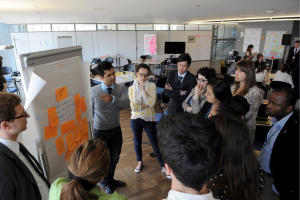The BeUpstanding™ team have recently been out and about talking to and interviewing champions, potential champions, teams, and workplaces about their experience of taking part in BeUpstanding. Today we are going to take a look at what discovery interviews are, what they are used for, and why we are doing them. Most importantly we are going to share some of the interesting things that we found.
What are discovery interviews?

Discovery interviews have one main purpose – and that is for the researcher (or product development team) to understand how the end user is actually using a product. In our case, they are giving us insights into why organisations and champions are taking up BeUpstanding, or why they might consider taking it up, as well as the barriers and facilitators to success. In this round of interviews, our discovery process has involved in-depth interviews with government departments, mining, and fast moving consumer goods (FMCG) companies, as well as on-site observations of work teams, both before and after putting BeUpstanding into practice.
Over the past several months we have conducted numerous interviews. We deliberately chose teams with varying levels of engagement with BeUpstanding. We interviewed teams that were actively using the program, teams that had attempted to implement BeUpstanding in their workplace and those that had signed up but not progressed any further. We listened to all of the interviews in person, re-listened to them, read the transcripts, and read the transcripts again. This process has allowed us to identify some things that we can quickly improve, but it has also given us the opportunity to link stories from different organisations together and identify underlying patterns and themes that are common between workplaces.
Everything you see in the BeUpstanding toolkit is evidence based and has been developed in conjunction with leading workplace policy and practice partners. We have also pilot tested all of the strategies included in the toolkit. But designing a product to be successful takes more than research. By taking what we have learned through the discovery interviews and through an iterative process, we are able to adjust, modify, and tweak our product to better support champions and their workplaces to stand up, sit less, and move more.
So, what did we find?
There were three (amongst many) really interesting themes to emerge from the discovery interviews that were common between all of our workplaces.
- Organisational culture is a key factor in determining the behaviour of staff.
- Management and workplace procedures have a leading role.
- Generational change in the workplace is coming: the millennial generation works a lot differently to the generations before it and they are motivated by different ideas about what work is and how we do it.
Organisational Culture
Organisational culture tells employees how things are done, what is important, and what kind of behaviour is rewarded.3 As you would expect an organisation’s culture plays a large role in the success of any organisational endeavour.
Effect of culture: “depending on the culture and the workplace and that sort of stuff. And sometimes it can be really hard to overcome” – Government Department
Whether it is a technology upgrade, a corporate restructure or the introduction of a workplace health intervention, the organisation’s culture will almost pre-determine the outcome. To make matters more complex, culture is dynamic, difficult to define, and incorporates a range of ideals. Further, there is not one unified culture, there are many sub-cultures that exist within an organisation, that relate to the broader, over-arching culture.4
Dynamic culture: “just because of the dynamic in this office, I don’t think it was ever going to work” – Mining company
Cultural issues are not new to the BeUpstanding team. In the Randomised Controlled Trials that helped form the evidence base for BeUpstanding, cultural challenges were identified as key barriers to the implementation of the program.5 Some of these have been addressed during the development of BeUpstanding, but during our discovery interviews similar themes emerged.
Does team culture play a role?: “Oh, hugely. Hugely. Some people embrace change, some people don’t and some completely resist and will do everything in their powers to derail that as far as possible” – Government Department
Organisational culture can be loosely defined as sets of assumptions, values, artefacts, and symbols and the relationships between them.4,6 For us, the relationship between values and artifacts is important. Using Schein’s Model of Organisational Culture,4 values are defined as the social principles, philosophies, goals, and standards considered to have intrinsic worth6 whereas artifacts are the tangible and visible components of organisational culture and include behavioural patterns, such as sitting.6 Through a process of retroactive realization, an introduced artifact can be transformed into a value. The BeUpstanding Toolkit is the artefact that we have introduced to the workplace. In our quest to make standing in the workplace “less weird”, how do we use retroactive realization to get our artefact to be accepted as an organisational value and therefore intrinsic to the organisation? We’re not sure yet, but there is probably a PhD thesis in there somewhere…
The Role of Management
The second stand-out theme to come out of the discovery interviews was the role of management in terms of running and approving the use of BeUpstanding in the workplace. What came through quite strongly was the disconnect between managers and their staff. Disconnect might not be the right word, but what came through in our interviews is that staff want management to provide opportunities to be involved in workplace initiatives.
Who should be responsible for identifying and running programs?
“it should be introduced by management”
“at the management level”
“it could be our section of the organization, our executive trying to establish some of those initiatives”
“if there was another program that came, if there was someone at that level (executive) to kind of, make it happen… consulted with the executive to get their support to help drive that program as well”
– From a Government Department
This ‘leading’ by management was seen to give the program legitimacy, by showing that they have ‘bought in’ to the program and signalling to employees that they are valued and worth investing in. In the research that informed the development of BeUpstanding, success was impacted by the level of involvement of team managers, the motivation and seniority of management involved as well as management promotion and support.5
Interestingly, the management level people that we spoke to had the opposite point of view. They felt that initiatives should be developed within the team.
“teams will self generate somethings. Yeah, it depends on the culture of the team a little bit as well, and the individuals involved” – Government Department
They identified that unless it was part of someone’s job it was put in the ‘too hard’ basket, but management acknowledged that they need to provide the time for staff to devote to running the program.
“their work is set for the entire day, so it’s really hard for them to find time to go and attend a session like that” – Staff, Government Department
“almost what I need to do as well is to say It is okay for you to invest time in this. So that you … they have that ‘okay’” – Manager, Government Department.
“giving them a boost in a bit of recognition of that they can actually mean something for the team would be really, really positive as well” – Manager, Government Department
Changing Demographics

The changing demographics of the workforce is having an impact on the workplace. The millennial generation wants flexibility in where and how they work, and they want the work they do to have meaning. They also want perks, but not the ones that you would expect. A Gallup poll7 showed that American millennial workers want access to things that are closely related to quality of life.
“I mean I guess I’m semi like health conscious. Like compared to most of my friends. I worry a bit more about like my body and deteriorating and all that stuff. But I was pretty … just hearing like what office life is normally like. That, you know, you just sitting at a desk for eight hours. I was like, that’s so bad for your health.” – FMCG Company
Forbes8 identified ergonomics and specifically sit/stand desks as a tool to help keep millennials healthy and happy.
“We have elevatable desks. Amazing! And we are encouraged to stand up and I was like, I love it” – FMCG Company
Our interviews showed that this generation care deeply about their health at work, and are conscious of the impact of sitting too much on their health.
“Well, I think perhaps also because like as students I started like working and before I developed any work habits, like I had these desks. … So I feel like I was lucky that like I haven’t built a habit of concentrating in a certain position” – FMCG Company
“you look at they’re two very different teams, one’s a very … the median age for them is very, very young, the team that you’re dealing with is and older cohort of staff you see the differences” – Manager, Government Department
This group of workers were conscious of the effects of sitting too much through the experience of their parents and were keen on developing good habits early in their working lives.
“I know my parents complain about, like shoulder pains, back pains. And I was like, I don’t want that to be me. So I was really excited with BeUpstanding. – FMCG Company
These are three, of the many, themes that came from our discovery interviews. The discovery process has provided us with data that we can use to iterate our way to a better version of BeUpstanding, helping you and your workplace to stand up, sit less, and move more.
This post was written by Jason Zischke as part of a Summer Scholarship program he participated in with the BeUpstanding™ team at UQ.
References
- Rubin, H.J, Rubin, I.S,Qualitative interviewing (2nd ed.): the art of hearing data, 2nd edn, SAGE Publications, Inc., Thousand Oaks, California, 2005
- Braun V, Clarke V. Using thematic analysis in psychology. Qualitative Research in Psychology. 2006; 3(2):77-101.
- Stone RJ. Human resource management. 8th ed.. ed: Milton, Qld. : John Wiley; 2014
- Eden R, Burton-Jones A. The Dynamics of Organizational Culture: The Case of Culture Work in a Digital Hospital. Thirty Ninth International Conference on Information Systems. 2018. 1-13.
- Brakenridge CL, Healy GN, Hadgraft NT, Young DC, Fjeldsoe BS. Australian employee perceptions of an organizational-level intervention to reduce sitting. Health Promotion International. 2018;33(6):968-79
- Hatch M. The Dynamic of Organizational Culture. Academy of Management Review. 1993;18(4):657-93
- (2019). State of the American Workplace. [online] Gallup.com. Available at: https://news.gallup.com/reports/199961/7.aspx [Accessed 31 Jan. 2019].
- Landrum, S. (2019). 5 Workspace Changes That Make Millennials Happy. [online] Forbes.com. Available at: https://www.forbes.com/sites/sarahlandrum/2017/10/12/5-workspace-changes-that-make-millennials-happy/#4c4f385a743a [Accessed 31 Jan. 2019]










Comments are closed.